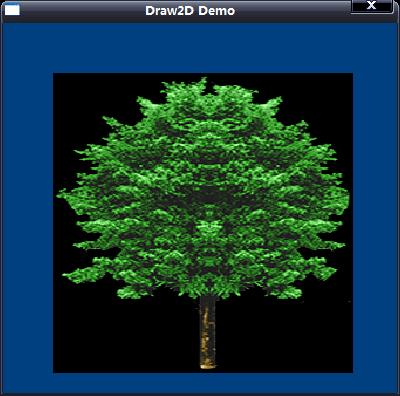思路如下:
(1)函数Do_Init初始化D3D,D3D设备,顶点缓冲,纹理;主要调用这几个函数:
Direct3DCreate9,GetAdapterDisplayMode,CreateDevice,CreateVertexBuffer, Lock,Unlock,D3DXCreateTextureFromFile。
(2)函数Do_Frame绘制一帧,主要调用这几个函数:
Clear,BeginScene,EndScene,SetStreamSource,SetFVF,SetTexture, DrawPrimitive。
(3)函数Do_Shutdown释放D3D资源。
源码如下:
/***************************************************************************************
PURPOSE:
2D Drawing Demo
Required libraries:
D3D9.LIB and D3DX9.LIB
***************************************************************************************/
#include <windows.h>
#include <stdio.h>
#include "d3d9.h"
#include "d3dx9.h"
#pragma comment(lib, "d3d9.lib")
#pragma comment(lib, "d3dx9.lib")
#define WINDOW_WIDTH 400
#define WINDOW_HEIGHT 400
#define Safe_Release(p) if((p)) (p)->Release();
// window handles, class and caption text.
HWND g_hwnd;
HINSTANCE g_inst;
static char g_class_name[] = "Draw2DClass";
static char g_caption[] = "Draw2D Demo";
// the Direct3D and device object
IDirect3D9* g_d3d = NULL;
IDirect3DDevice9* g_d3d_device = NULL;
// The 2D vertex format and descriptor
typedef struct
{
float x, y, z; // 2D coordinates
float rhw; // rhw
float u, v; // texture coordinates
} VERTEX;
#define VERTEX_FVF (D3DFVF_XYZRHW | D3DFVF_TEX1)
IDirect3DVertexBuffer9* g_vertex_buffer = NULL;
IDirect3DTexture9* g_texture = NULL;
//--------------------------------------------------------------------------------
// Window procedure.
//--------------------------------------------------------------------------------
long WINAPI Window_Proc(HWND hwnd, UINT msg, WPARAM wParam, LPARAM lParam)
{
switch(msg)
{
case WM_DESTROY:
PostQuitMessage(0);
return 0;
}
return (long) DefWindowProc(hwnd, msg, wParam, lParam);
}
//--------------------------------------------------------------------------------
// Initialize d3d, d3d device, vertex buffer, texutre.
//--------------------------------------------------------------------------------
BOOL Do_Init()
{
D3DPRESENT_PARAMETERS present_param;
D3DDISPLAYMODE display_mode;
BYTE* vertex_ptr;
// initialize vertex data
VERTEX verts[] = {
{ 50.0f, 50.0f, 1.0f, 1.0f, 0.0f, 0.0f },
{ 350.0f, 50.0f, 1.0f, 1.0f, 1.0f, 0.0f },
{ 50.0f, 350.0f, 1.0f, 1.0f, 0.0f, 1.0f },
{ 350.0f, 350.0f, 1.0f, 1.0f, 1.0f, 1.0f }
};
// do a windowed mode initialization of Direct3D
if((g_d3d = Direct3DCreate9(D3D_SDK_VERSION)) == NULL)
return FALSE;
// retrieves the current display mode of the adapter
if(FAILED(g_d3d->GetAdapterDisplayMode(D3DADAPTER_DEFAULT, &display_mode)))
return FALSE;
ZeroMemory(&present_param, sizeof(present_param));
// initialize d3d presentation parameter
present_param.Windowed = TRUE;
present_param.SwapEffect = D3DSWAPEFFECT_DISCARD;
present_param.BackBufferFormat = display_mode.Format;
// creates a device to represent the display adapter
if(FAILED(g_d3d->CreateDevice(D3DADAPTER_DEFAULT, D3DDEVTYPE_HAL, g_hwnd,
D3DCREATE_SOFTWARE_VERTEXPROCESSING, &present_param, &g_d3d_device)))
return FALSE;
// create the vertex buffer and set data
g_d3d_device->CreateVertexBuffer(sizeof(VERTEX) * 4, 0, VERTEX_FVF, D3DPOOL_DEFAULT, &g_vertex_buffer, NULL);
// locks a range of vertex data and obtains a pointer to the vertex buffer memory
g_vertex_buffer->Lock(0, 0, (void**)&vertex_ptr, 0);
memcpy(vertex_ptr, verts, sizeof(verts));
// unlocks vertex data
g_vertex_buffer->Unlock();
// load the texture map
D3DXCreateTextureFromFile(g_d3d_device, "Texture.bmp", &g_texture);
return TRUE;
}
//--------------------------------------------------------------------------------
// Release all d3d resource.
//--------------------------------------------------------------------------------
BOOL Do_Shutdown()
{
Safe_Release(g_vertex_buffer);
Safe_Release(g_texture);
Safe_Release(g_d3d_device);
Safe_Release(g_d3d);
return TRUE;
}
//--------------------------------------------------------------------------------
// Render a frame.
//--------------------------------------------------------------------------------
BOOL Do_Frame()
{
// clear device back buffer
g_d3d_device->Clear(0, NULL, D3DCLEAR_TARGET, D3DCOLOR_RGBA(0, 64, 128, 255), 1.0f, 0);
// Begin scene
if(SUCCEEDED(g_d3d_device->BeginScene()))
{
// set the vertex stream, shader, and texture.
// binds a vertex buffer to a device data stream
g_d3d_device->SetStreamSource(0, g_vertex_buffer, 0, sizeof(VERTEX));
// set the current vertex stream declation
g_d3d_device->SetFVF(VERTEX_FVF);
// assigns a texture to a stage for a device
g_d3d_device->SetTexture(0, g_texture);
// renders a sequence of noindexed, geometric primitives of the specified type from the current set
// of data input stream.
g_d3d_device->DrawPrimitive(D3DPT_TRIANGLESTRIP, 0, 2);
// release texture
g_d3d_device->SetTexture(0, NULL);
// end the scene
g_d3d_device->EndScene();
}
// present the contents of the next buffer in the sequence of back buffers owned by the device
g_d3d_device->Present(NULL, NULL, NULL, NULL);
return TRUE;
}
//--------------------------------------------------------------------------------
// Main function, routine entry.
//--------------------------------------------------------------------------------
int WINAPI WinMain(HINSTANCE inst, HINSTANCE, LPSTR cmd_line, int cmd_show)
{
WNDCLASSEX win_class;
MSG msg;
g_inst = inst;
// create window class and register it
win_class.cbSize = sizeof(win_class);
win_class.style = CS_CLASSDC;
win_class.lpfnWndProc = Window_Proc;
win_class.cbClsExtra = 0;
win_class.cbWndExtra = 0;
win_class.hInstance = inst;
win_class.hIcon = LoadIcon(NULL, IDI_APPLICATION);
win_class.hCursor = LoadCursor(NULL, IDC_ARROW);
win_class.hbrBackground = NULL;
win_class.lpszMenuName = NULL;
win_class.lpszClassName = g_class_name;
win_class.hIconSm = LoadIcon(NULL, IDI_APPLICATION);
if(! RegisterClassEx(&win_class))
return FALSE;
// create the main window
g_hwnd = CreateWindow(g_class_name, g_caption, WS_CAPTION | WS_SYSMENU, 0, 0,
WINDOW_WIDTH, WINDOW_HEIGHT, NULL, NULL, inst, NULL);
if(g_hwnd == NULL)
return FALSE;
ShowWindow(g_hwnd, SW_NORMAL);
UpdateWindow(g_hwnd);
// initialize game
if(Do_Init() == FALSE)
return FALSE;
// start message pump, waiting for signal to quit.
ZeroMemory(&msg, sizeof(MSG));
while(msg.message != WM_QUIT)
{
if(PeekMessage(&msg, NULL, 0, 0, PM_REMOVE))
{
TranslateMessage(&msg);
DispatchMessage(&msg);
}
// draw a frame
if(Do_Frame() == FALSE)
break;
}
// run shutdown function
Do_Shutdown();
UnregisterClass(g_class_name, inst);
return (int) msg.wParam;
}
效果:
